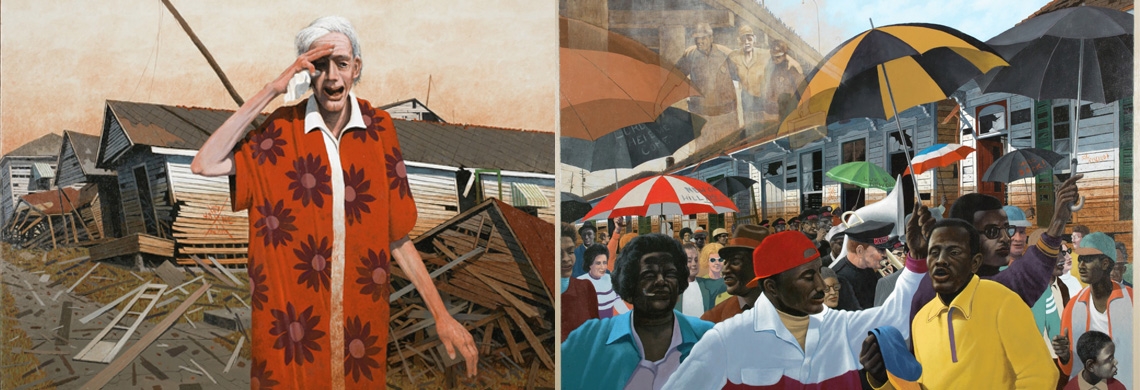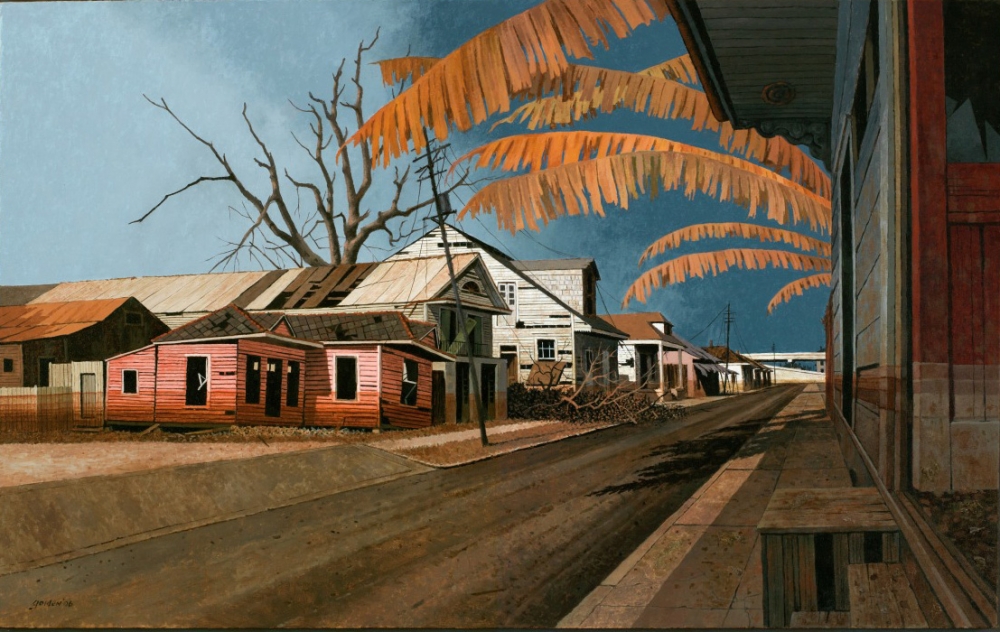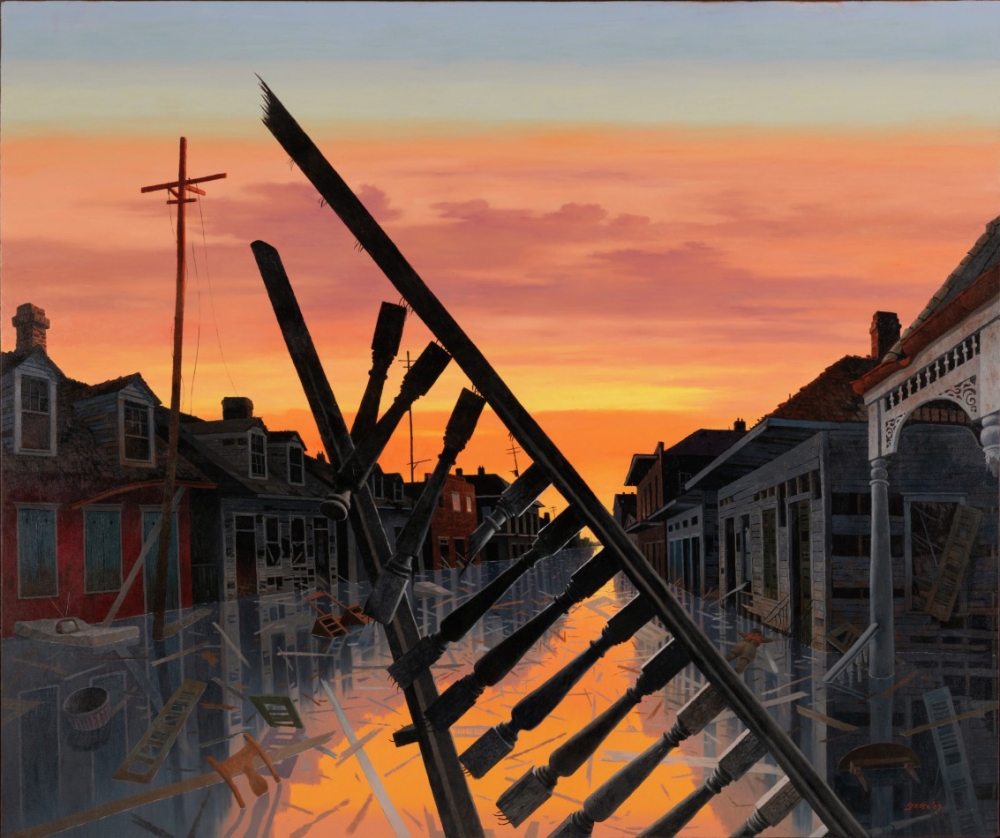A native of New Orleans, artist Rolland Golden (1931–2019) was distraught seeing news coverage of the city as it flooded after Hurricane Katrina. Golden watched in horror as great numbers of stranded people needed rescue. He had painted scenes around Louisiana, Mississippi, New England, New York, and abroad, but his career began in the French Quarter in the late 1950s. New Orleans was always the heartbeat of his artistic inspiration.
Over the course of the two years after Hurricane Katrina, Golden roamed the city’s flooded areas, sketching and painting a series of 26 scenes representing the turmoil and devastation during the flood and the stark desolation after the waters receded. The paintings are a melancholy document of the condition of the neighborhoods, especially Tremé, after 80 percent of the city had flooded. In all but one work, a watercolor and gouache on paper titled Christmas Eve, Golden used acrylic paint on canvas to render the subjects.
In 2007 the series of paintings, which he titled Katrina: Days of Terror, Months of Anguish, were exhibited at the New Orleans Museum of Art. In a rare joint acquisition, The Historic New Orleans Collection and NOMA purchased 13 of the paintings (shown below) and preliminary sketches with the financial support of THNOC’s Laussat Society; the Diane Helis Henry Art Fund of The Helis Foundation; and NOMA’s Sydney and Walda Besthoff Fund. Golden and his wife, Stella, later donated another of the paintings, Death by Drowning, under the joint ownership of THNOC and NOMA.
1. Arches of Misery
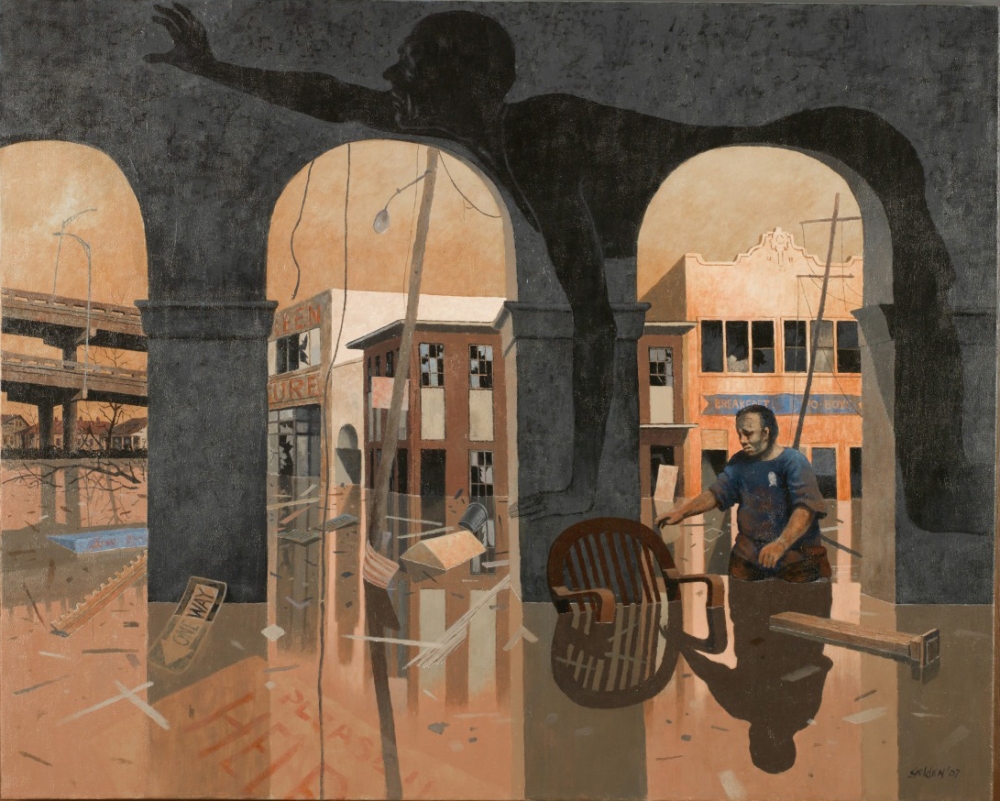 A man walks through hip-deep, debris-filled floodwater under the arches of Circle Grocery at North Claiborne Avenue and St. Bernard Street. His arms reach toward a submerged wooden armchair. On the archway above him appears the gray shadow of a man crawling with one arm outstretched for help. (See the catalog record here.)
A man walks through hip-deep, debris-filled floodwater under the arches of Circle Grocery at North Claiborne Avenue and St. Bernard Street. His arms reach toward a submerged wooden armchair. On the archway above him appears the gray shadow of a man crawling with one arm outstretched for help. (See the catalog record here.)
2. Christmas Eve
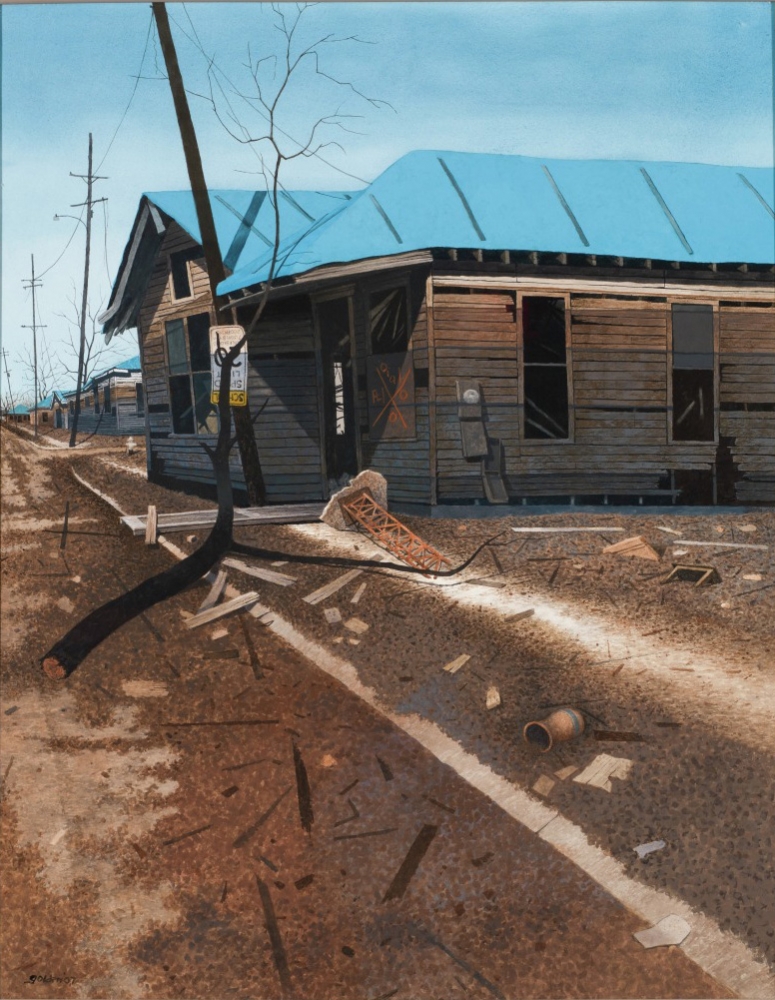 This is the only painting in the series to use watercolor and gouache on paper process rather than acrylic on canvas. It shows a muddy neighborhood street and houses with blue-tarped roofs. Brown waterlines on the houses mark the depth of the floodwaters as they receded. A red marker with coded numbers indicates no dead bodies were found inside the house. (See the catalog record here.)
This is the only painting in the series to use watercolor and gouache on paper process rather than acrylic on canvas. It shows a muddy neighborhood street and houses with blue-tarped roofs. Brown waterlines on the houses mark the depth of the floodwaters as they receded. A red marker with coded numbers indicates no dead bodies were found inside the house. (See the catalog record here.)
3. Claiborne Avenue
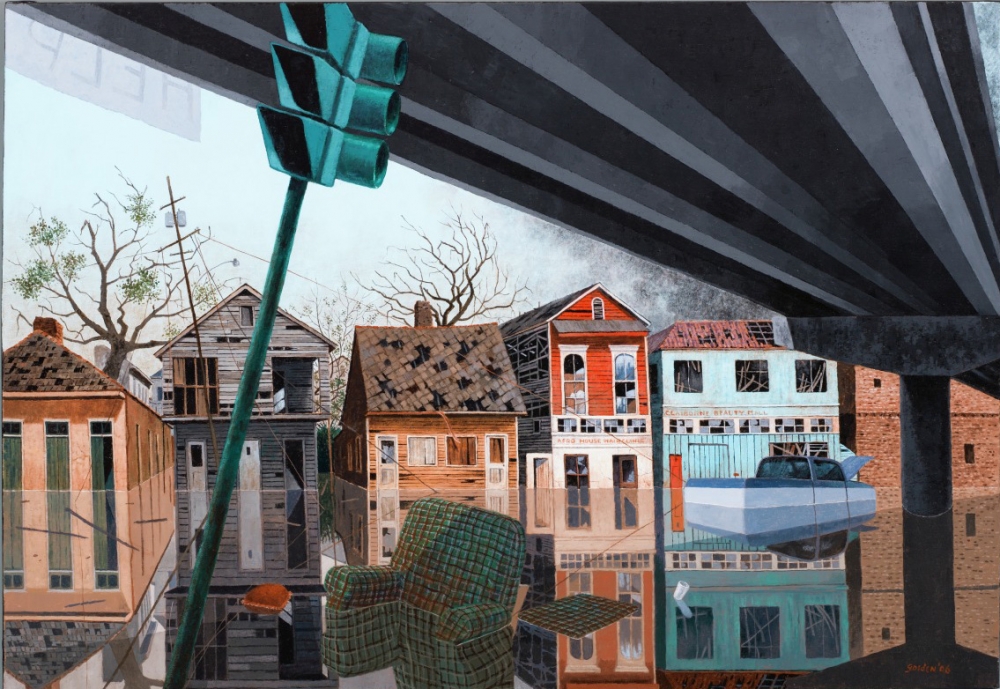 Golden often included detailed depictions of architecture in his career, and those skills remain evident in this series. Here a row of houses and shops stands on Claiborne Avenue near the raised expressway. A “Help” sign hanging on the expressway is partially visible near a tilted stoplight in the foreground. A submerged upholstered chair floats in the floodwaters while the hood of a pickup truck has popped open. (See the catalog record here.)
Golden often included detailed depictions of architecture in his career, and those skills remain evident in this series. Here a row of houses and shops stands on Claiborne Avenue near the raised expressway. A “Help” sign hanging on the expressway is partially visible near a tilted stoplight in the foreground. A submerged upholstered chair floats in the floodwaters while the hood of a pickup truck has popped open. (See the catalog record here.)
4. Desperation
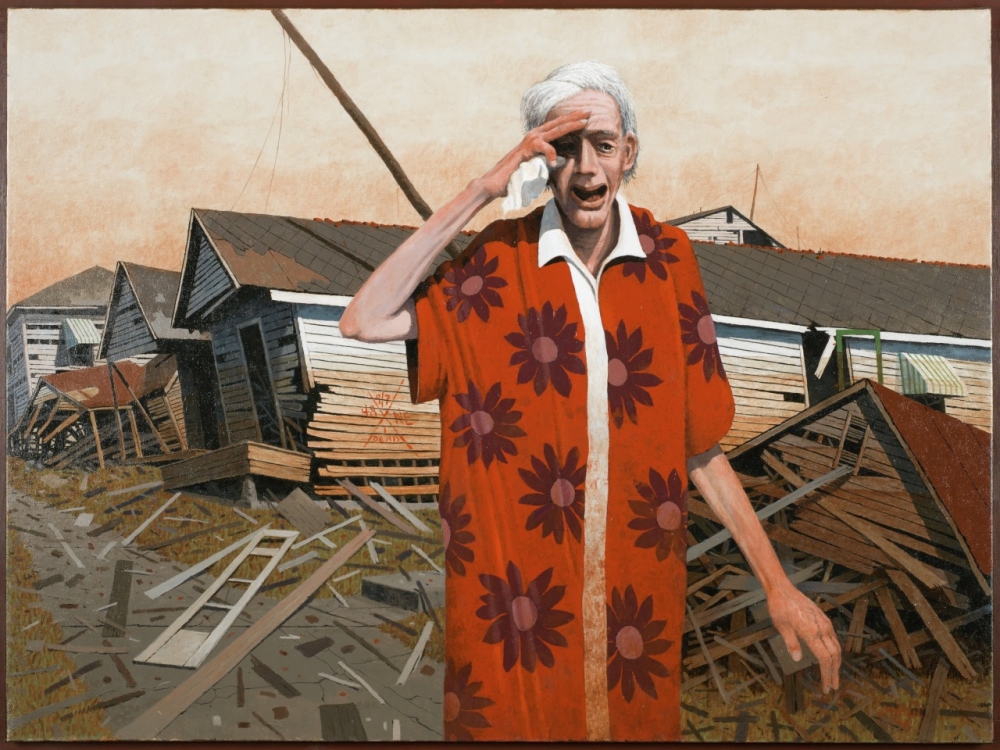 Golden interviewed this distraught elderly woman whose only possessions were the mud-stained flowered red housedress she wears and the handkerchief she carries. She cries near a row of destroyed wood-frame houses washed off their foundations. A red X with coded numbers records one dead person found inside the home. A downed utility pole and the debris-strewn ground shows the power of the hurricane winds. (See the catalog record here.)
Golden interviewed this distraught elderly woman whose only possessions were the mud-stained flowered red housedress she wears and the handkerchief she carries. She cries near a row of destroyed wood-frame houses washed off their foundations. A red X with coded numbers records one dead person found inside the home. A downed utility pole and the debris-strewn ground shows the power of the hurricane winds. (See the catalog record here.)
5. Elysian Fields—Land of the Gods
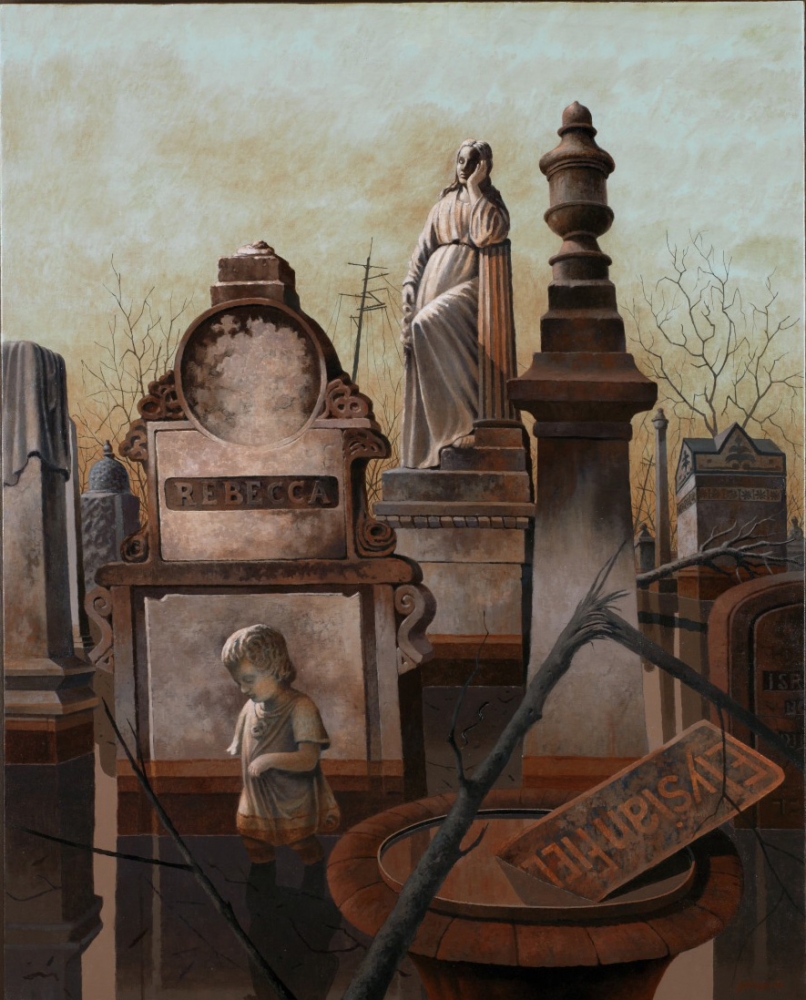 Brown watermarks stain tombs and the sculpture of a child who appears to walk through receding floodwater. The partially submerged street sign for Elysian Fields refers to the broad street running from the Lower Mississippi River to Lake Pontchartrain. The name also refers to the paradise, Elysium, that is the final resting place of heroes in Greek mythology. (See the catalog record here.)
Brown watermarks stain tombs and the sculpture of a child who appears to walk through receding floodwater. The partially submerged street sign for Elysian Fields refers to the broad street running from the Lower Mississippi River to Lake Pontchartrain. The name also refers to the paradise, Elysium, that is the final resting place of heroes in Greek mythology. (See the catalog record here.)
6. Escape
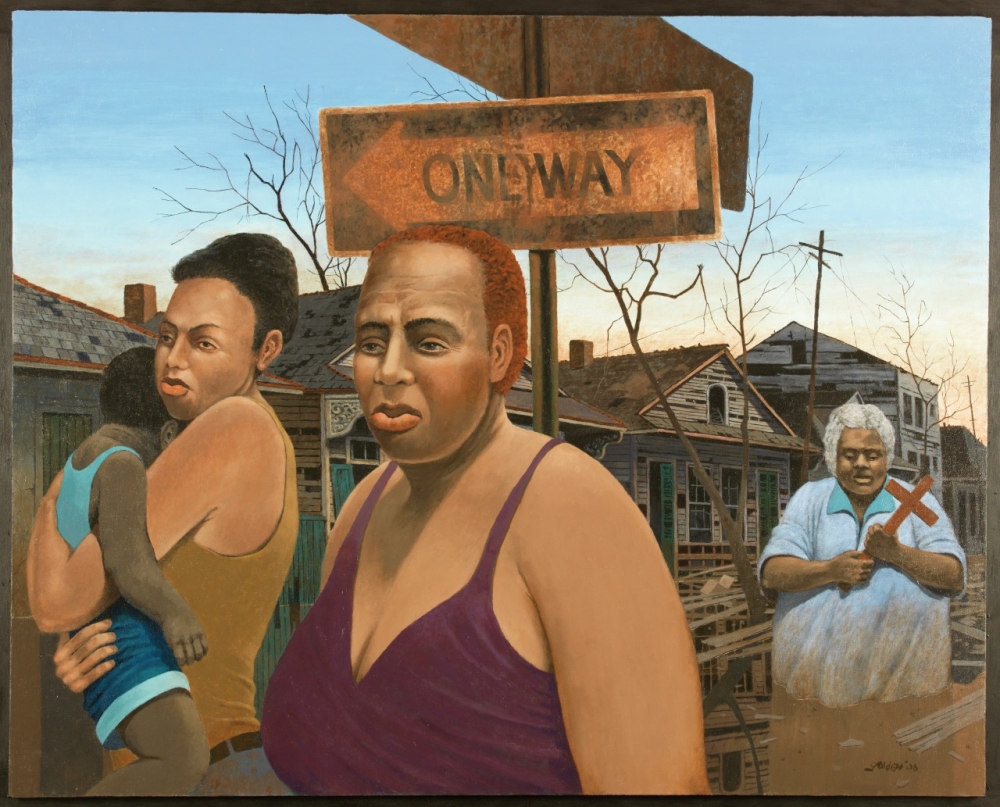 Women walk through floodwaters past damaged homes and dead trees. One woman carries a child while another clutches a wooden cross. A one-way street sign, covered with a film of sludge, offers no direction for safety. (See the catalog record here.)
Women walk through floodwaters past damaged homes and dead trees. One woman carries a child while another clutches a wooden cross. A one-way street sign, covered with a film of sludge, offers no direction for safety. (See the catalog record here.)
7. Heading for the Superdome
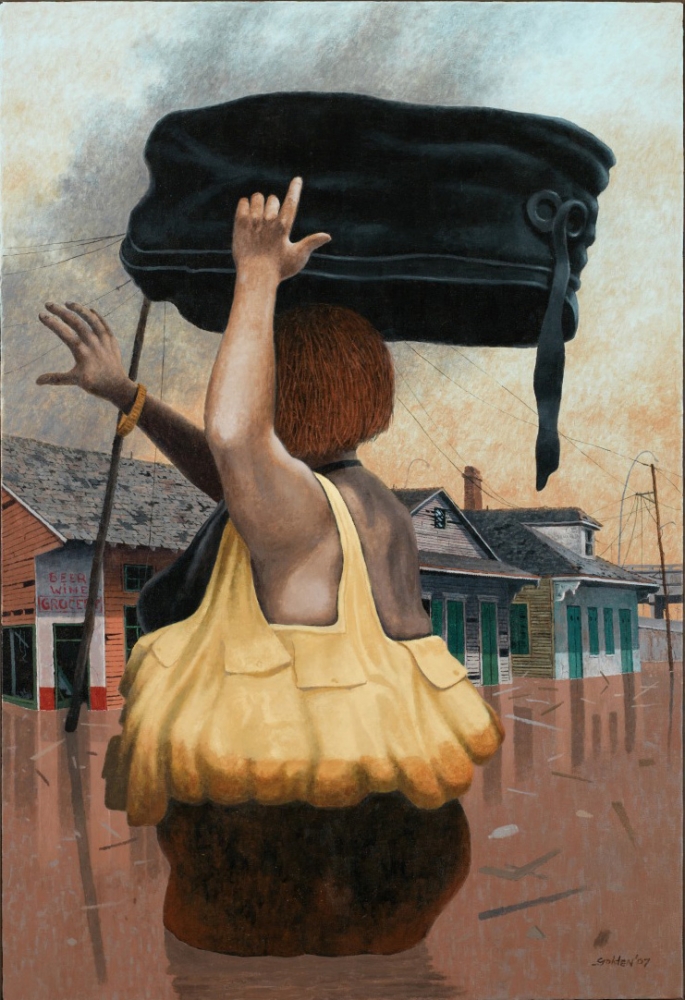 The Superdome had been named a "shelter of last resort" prior to Hurricane Katrina's landfall. When the city flooded, many residents headed to the landmark venue seeking refuge, unaware that it, too, was damaged, overcrowded, and without basic resources such as electricity and water. In this work, Golden shows a woman walking through floodwaters carrying a black suitcase atop her head and a yellow shoulder bag dampened by the brown water. A row of damaged houses, downed powerlines, and the raised expressway complete the image. (See the catalog record here.)
The Superdome had been named a "shelter of last resort" prior to Hurricane Katrina's landfall. When the city flooded, many residents headed to the landmark venue seeking refuge, unaware that it, too, was damaged, overcrowded, and without basic resources such as electricity and water. In this work, Golden shows a woman walking through floodwaters carrying a black suitcase atop her head and a yellow shoulder bag dampened by the brown water. A row of damaged houses, downed powerlines, and the raised expressway complete the image. (See the catalog record here.)
8. Helicopter Hands
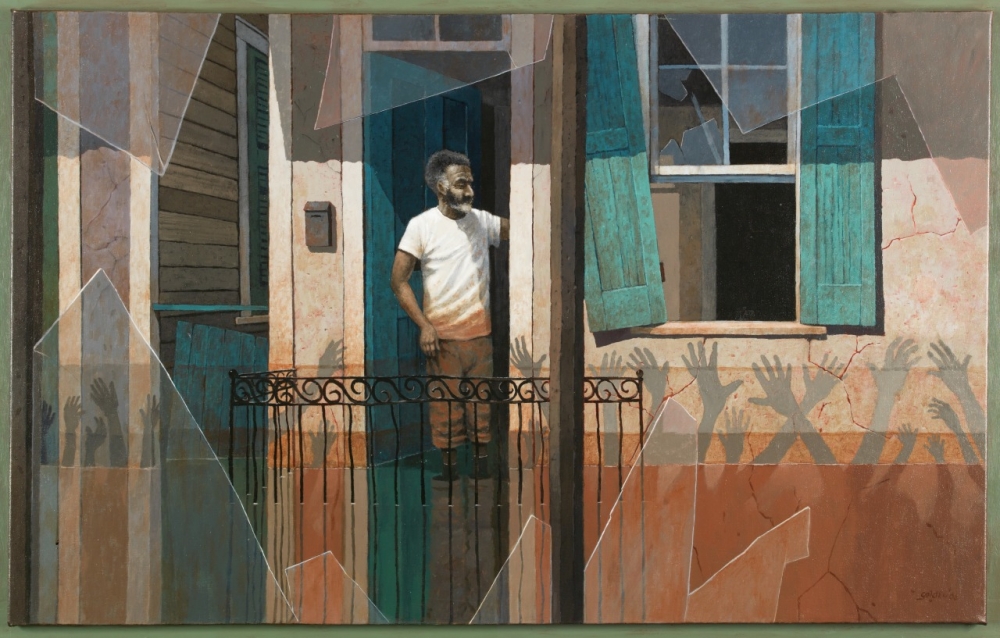 A man stands in the doorway of his flooded home; its window is broken and a blue shutter hangs askew from its hinges. The shadows of upraised hands and arms appear on his home, as though rising from the water. Shards of glass frame the scene, as though the viewer is looking through a broken window. (See the catalog record here.)
A man stands in the doorway of his flooded home; its window is broken and a blue shutter hangs askew from its hinges. The shadows of upraised hands and arms appear on his home, as though rising from the water. Shards of glass frame the scene, as though the viewer is looking through a broken window. (See the catalog record here.)
9. Push Came to Shove
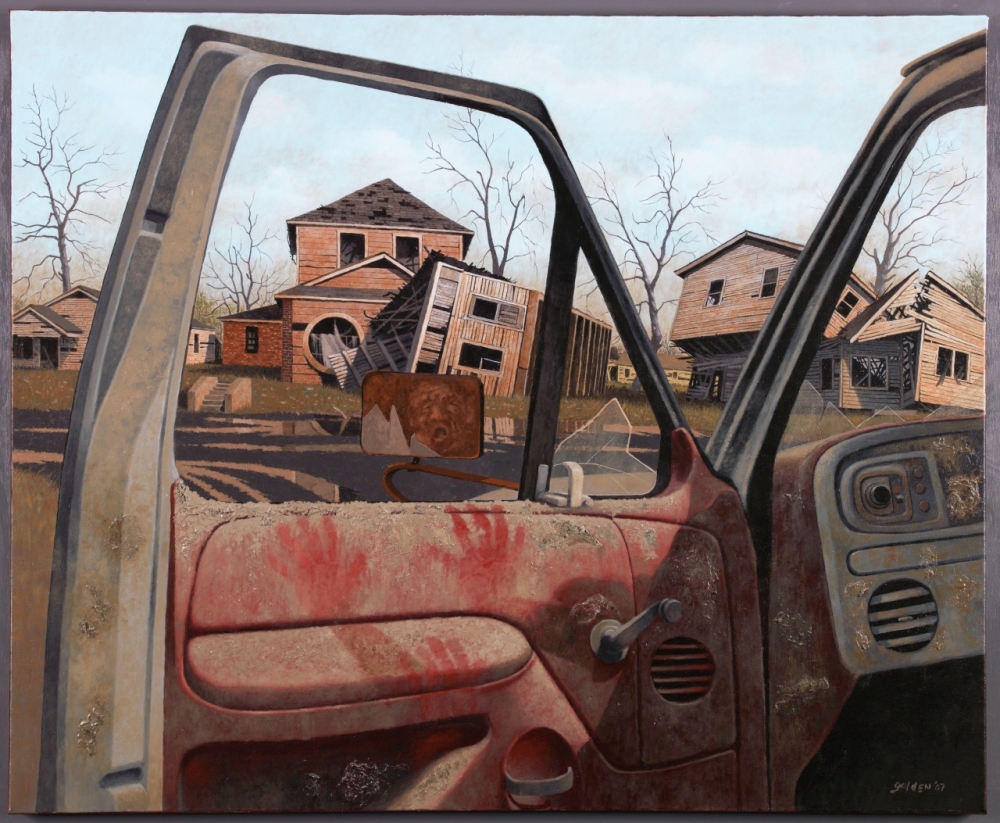 A flooded vehicle sits with its door open and marked with three handprints. The interior is covered with a layer of muck; an anguished face appears in the broken rear-view mirror. A row of destroyed homes—captured with incredible detail—is visible in the background. (See the catalog record here.)
A flooded vehicle sits with its door open and marked with three handprints. The interior is covered with a layer of muck; an anguished face appears in the broken rear-view mirror. A row of destroyed homes—captured with incredible detail—is visible in the background. (See the catalog record here.)
10. The Other Side of Caution
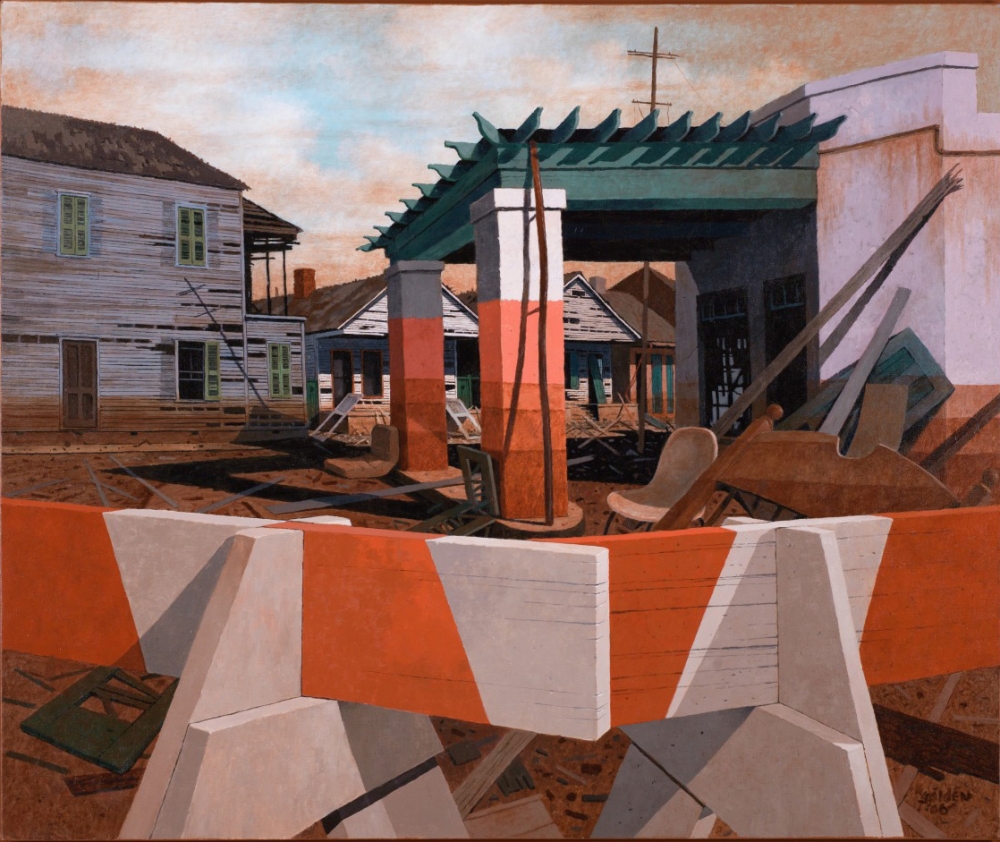 Two orange-and-white barricades block a street having damaged houses and downed powerlines. A white corner building has a pergola supported by two square columns. The building is surrounded by debris, including household furniture. (See the catalog record here.)
Two orange-and-white barricades block a street having damaged houses and downed powerlines. A white corner building has a pergola supported by two square columns. The building is surrounded by debris, including household furniture. (See the catalog record here.)
11. Throw Me a Line, Mister
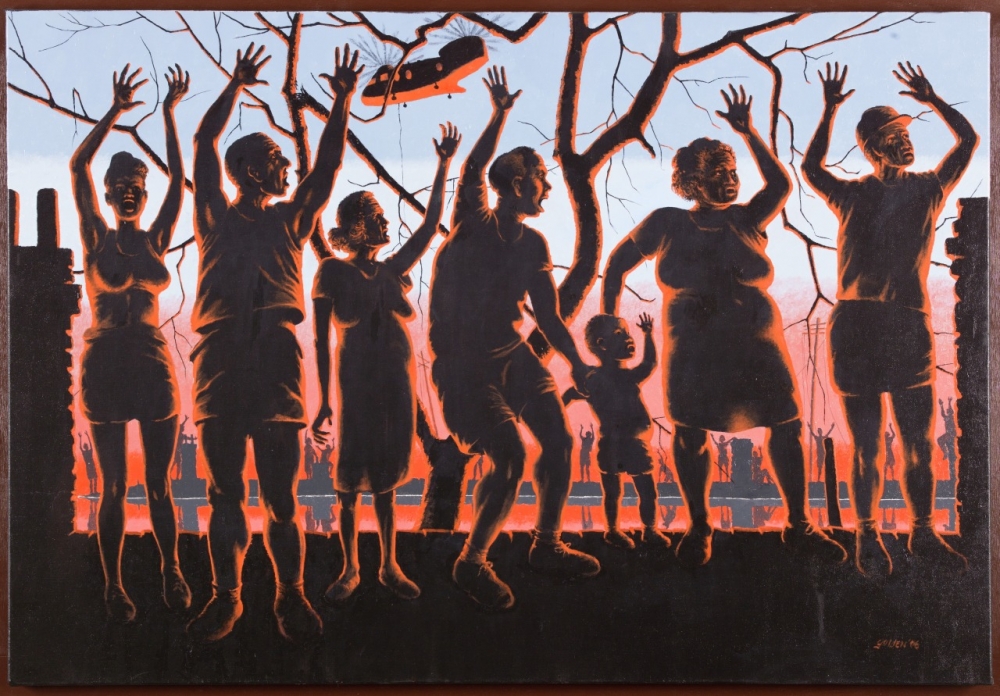 A group of people stand on a rooftop at dusk, waving to helicopters to be rescued during the evacuation after Hurricane Katrina. People silhouetted in the background, also stranded on rooftops, wave for help. The title is an anguished reference to Mardi Gras crowds yelling at masked float riders to “Throw me something, Mister.” (See the catalog record here.)
A group of people stand on a rooftop at dusk, waving to helicopters to be rescued during the evacuation after Hurricane Katrina. People silhouetted in the background, also stranded on rooftops, wave for help. The title is an anguished reference to Mardi Gras crowds yelling at masked float riders to “Throw me something, Mister.” (See the catalog record here.)
12. Tremé
After Hurricane Katrina, damaged houses lined the streets throughout the city of New Orleans. This street in the Tremé neighborhood shows the city after the water receded, with brown muck covering everything, and all foliage having turned brown, including grass and banana trees. Tremé is one of this nation’s oldest African American neighborhoods. (See the catalog record here.)
13. Death by Drowning
This view of a flooded street in post-Katrina New Orleans shows receding waters still up to the door jambs. A broken, twisted bannister demonstrates the power of the winds. A lifeless body floats in the water along with furniture, shutters, mattresses, a garbage can, and debris. (See the catalog record here.)
14. The Spirit Returns
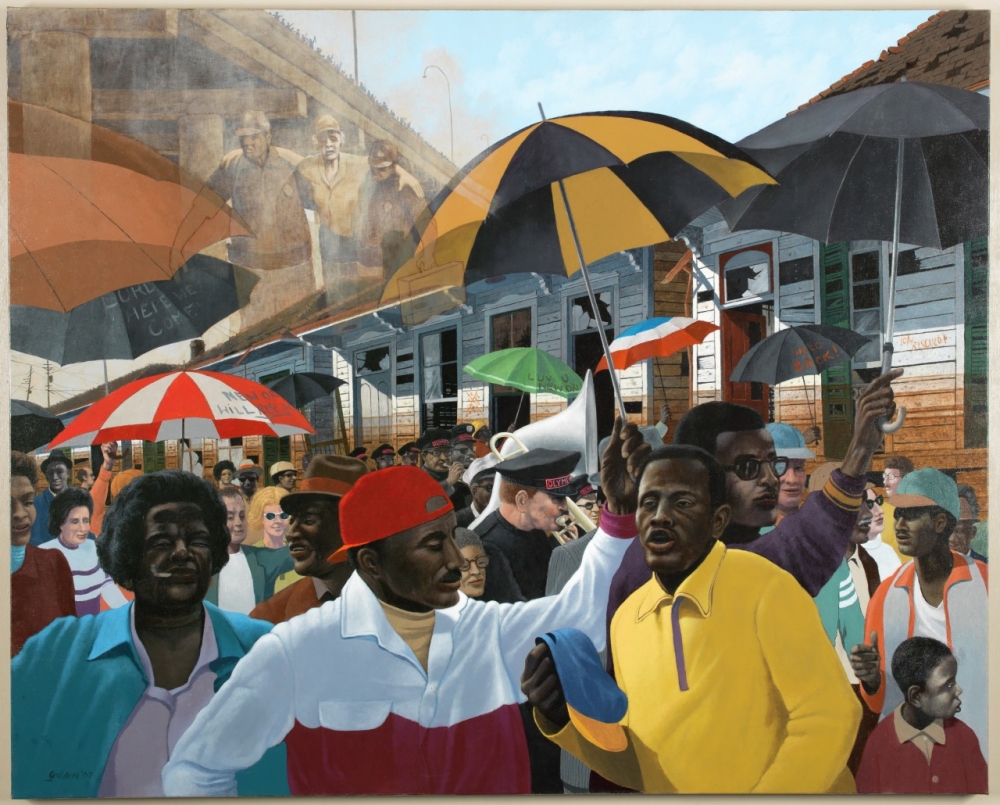 Crowds surround the Olympia Brass Band as they parade past damaged houses with broken windows and brown waterlines. People have returned to their homes to rebuild their lives, and several of them carry umbrellas with encouraging slogans. Hovering above at top right is a ghostly scene representing two rescue workers assisting an elderly man. People line a highway overpass waiting for help. That upbeat scene restores hope for viewers who first encounter the paintings with scenes of devastation—but there is still that haunting reminder in the top left, thoughts that for many of us are daily reoccurrences. (See the catalog record here.)
Crowds surround the Olympia Brass Band as they parade past damaged houses with broken windows and brown waterlines. People have returned to their homes to rebuild their lives, and several of them carry umbrellas with encouraging slogans. Hovering above at top right is a ghostly scene representing two rescue workers assisting an elderly man. People line a highway overpass waiting for help. That upbeat scene restores hope for viewers who first encounter the paintings with scenes of devastation—but there is still that haunting reminder in the top left, thoughts that for many of us are daily reoccurrences. (See the catalog record here.)

